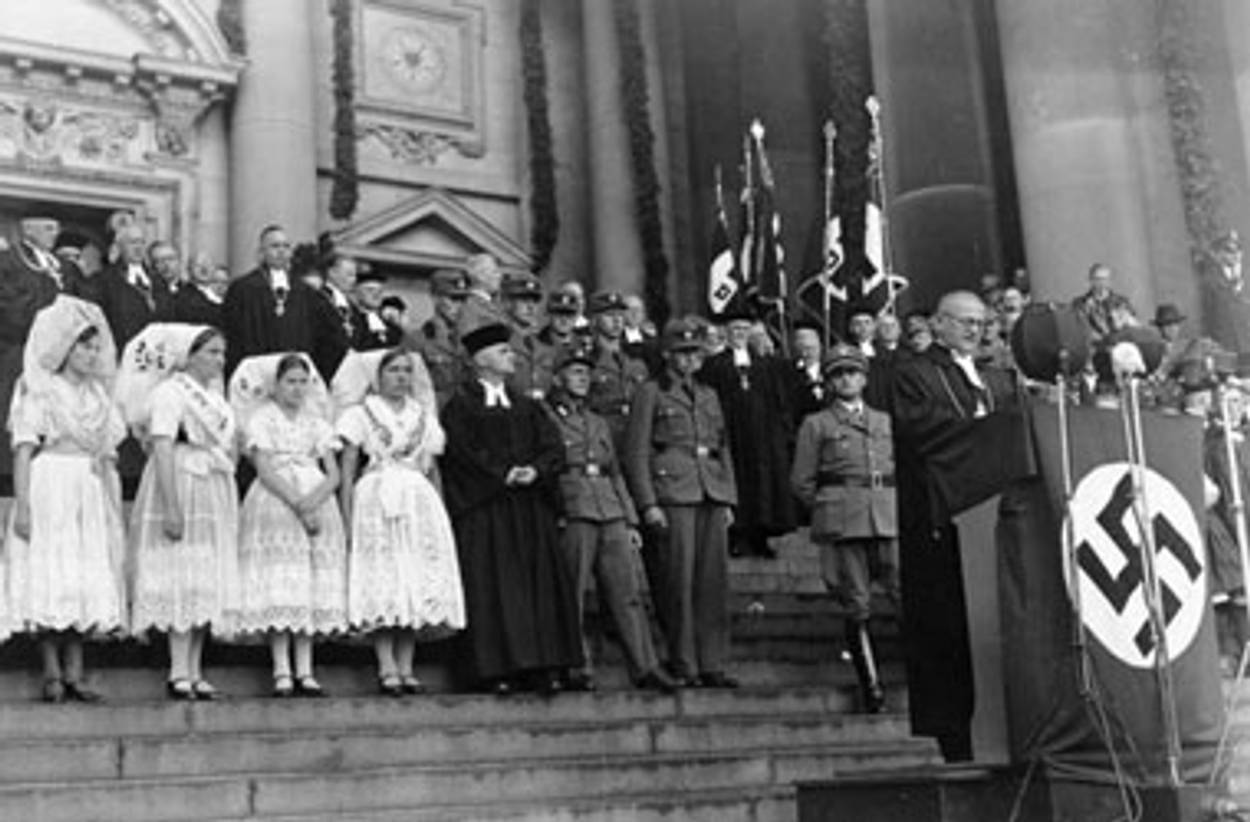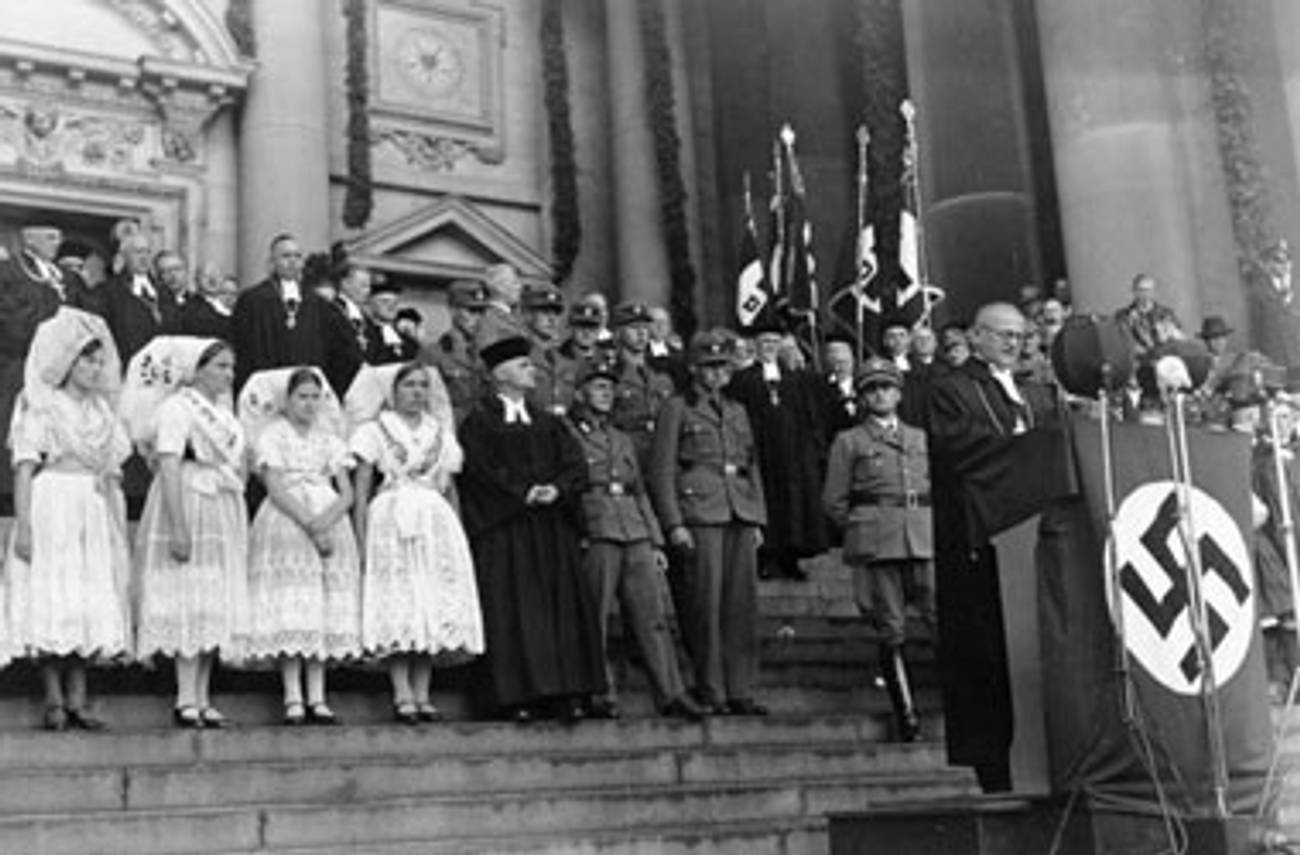The Nazi of Nazareth
A new history examines the German theologians who made a Jesus in their own image




Even before opening the book, the reader is confronted with the moral perversity exposed and explored in Susannah Heschel’s Aryan Jesus. Front and center on its cover, symbolic universes that should have clashed instead mesh neatly in a 1935 photograph of a church interior in Cologne: on an altar dominated by the huge swastika of a National Socialist flag stands the figure of the crucified Christ. Neither heaven, nor history, nor the Bible itself, could escape the awful logic of racism. If Germany were a Christian nation (and it was), and if the true German nation were Aryan (thus popular assertion), then Christianity, and most specifically Jesus of Nazareth, had to be Aryan, too.
Heschel’s important book traces the rise of the Institute for the Study and Eradication of Jewish Influence on German Church Life (Institut zur Erforschung und Beseitigung des jüdischen Einflusses auf das deutsche kirchlichen Leben). Formed in May 1939, the Institute dedicated itself to ridding Christianity of its Jewish “excrescences,” and to presenting back to the German Volk a “Nordic” Christ and an Aryan Christianity restored to their original purity. To this end, Institute theologians availed themselves of every means possible to establish and to promote their message. They produced readings of the New Testament interpreted according to anti-Jewish racism. They unctuously solicited the financial and political support of the Nazi party. They disseminated their anti-Semitic message through typical academic media: sponsored “research,” journal articles, books, funded conferences, graduate training, public lectures. And, since Germany’s was a state church, they brought their Aryan agenda to the people in the pew: altering the texts of the New Testament (in German translation), re-writing liturgy, vigorously advocating and preaching that the (Jewish) Old Testament be dropped as Christian scripture.
These theological positions all predate Hitler’s rise to power and the Institute’s foundation. In one sense, these theologians were simply engaged in a time-honored Christian project: efforts to de-Judaize Christianity are almost as ancient as Christianity itself. Though the earliest core writings in the New Testament—Paul’s letters and the four canonical gospels—were themselves the products of first-century Hellenistic synagogue culture, some later Gentile interpreters came to read these texts’ intra-Jewish debates as condemnations of Judaism in its entirety. By the fourth century, with few exceptions, orthodox theologians agreed that Judaism was an awful religion, rightly rejected by Jesus and by Paul, by the prophets before them, and (on the evidence of pagan Rome’s destruction of Jerusalem and its temple in 70 C.E.), by God himself.
Several important differences, however, distinguish this classical Christian anti-Judaism from its 20th-century German avatar. First, emperors always recognized and legally protected the Jews’ religious prerogative: gentiles’ conversion to Judaism (whether from paganism or from Christianity) was what roused ire and anxiety. Second, Jews for the most part could stop “being” Jews if they converted to Christianity: despite antiquity’s own forms of racism, and its own linking of ethnicity to religion, social identity could change along with religious affiliation. And third, Roman Christianity built itself upon the idea of Israel enunciated in the orthodox reading of Jewish scripture: Hebrew was recognized as the Old Testament’s premier language, the Jewish homeland became the church’s Holy Land, the empire and its theologians viewed Christian Rome as the true heir to the biblical promises to Israel. In short, Christians powerfully, fundamentally, and self-consciously incorporated a lot of Jewish texts, concepts, and even practices into their own identity.
Medieval Europe and modern pseudoscientific racism eroded much of this religious and social legacy. Eventually, crusade and inquisition sanctioned the choice of forced conversion or death; Jewish converts to Christianity, regarded with suspicion, remained in their own peculiar category. But 20th-century Germany’s marriage of fascism, nationalism, and racism radicalized all earlier Christian anti-Jewish agendas. “The Jew,” German thinkers now said, could never be anything else, neither truly Christian nor truly German. Worse—a fantastic projection of German anti-Semitism onto Jewish Germans—Jews were described as power-obsessed, homicidal, bent on world domination, indeed “satanic.” If Jews could never be culturally assimilated, religiously converted, or morally redeemed, if they could never truly be German Protestants, then what was Christian Germany to do with Germany’s Jews? In 1936, at a meeting of church leaders from Thuringia and Saxony, the later Institute fixture Siegfried Leffler pronounced the German Christian answer:
In a Christian life, the heart always has to be disposed toward the Jew. . . . As a Christian, I can, I must, and I ought always to have or to find a bridge to the Jew in my heart. But as a Christian, I also have to follow the laws of my Volk. . . . Even if I know that “thou shalt not kill” is a commandment of God, or that “thou shalt love the Jew” because he too is a child of the eternal Father, I am able to know as well that I have to kill him, I have to shoot him. And I can only do that if I am permitted to say: Christ.
This Christian call to murder Jews met with no protest or even criticism from the others present. As Heschel notes, “Ridding Germany of Jews had become an acceptable point of discussion among theologians, even when murder was proposed as a technique of achieving it.” In the name of Aryan purity, these theologians outdid even the Nazis: 1936 was well before the mass murder of Jews became Nazi policy.
Heschel dedicates the first 200 pages of her study to reconstructing the Institute’s programs and policies. And “reconstruct” she must because, despite its prodigious productivity and political activism – indeed, despite the 600,000 pastors, bishops, professors of theology, religious instructors and committed laypeople comprising its membership—the Institute became all but invisible in the wake of the war. This last story, which Heschel recounts in her closing two chapters, sickens in a different way. Christian champions of Jewish genocide, the Institute’s leaders ran for cover once the Allies won the war, writing letters of exoneration for each other, shielded by the church, their colleagues, and their own mendacity. Those who during the war had used their academic expertise in Judaism to further the Institute’s racist agenda now, during the peace, used this expertise as camouflage: how could experts in Judaism be anti-Semitic? And the resonance between the Institute’s own anti-Judaism and that of traditional Christian theology made its criminality virtually impossible to see. As a result, many of the Institute’s prime players went on to have long and distinguished postwar academic careers as scholars of the New Testament. (I realized, with a jolt, that I had read some of their works in the course of my own graduate training in the 1970s.)
The Aryan Jesus, in consequence, is more than a heartsickening story of principled Christian anti-Judaism. It is also a masterwork of patient archival research. The lion’s share of Heschel’s data lay buried in regional library archives and in personal correspondence. She not only retrieved these documents, but she also interviewed surviving spouses and students of the Institute’s theologians. As she reveals, post-war academic careers were enhanced, not diminished, by Institute involvement: the professional network of loyalty and patronage remained effective and intact. While these men had to renounce their earlier activism—after 1945, they could no longer champion homicidal racism or noisily advocate for a Christian bible minus the Old Testament and minus “Jewish” concepts and words (like “messiah,” alleluia,” and “amen”) in the New Testament—their academic and theological anti-Judaism was unimpaired.
Both as a history of German anti-Semitism and as an analysis of pronounced themes within Christian theology, Heschel’s study is both broad and deep. I warmly hope that its success among general readers—a success it richly deserves—does not obscure its immediate relevance to students of divinity, and especially to scholars of the New Testament today. Despite the energy and commitment of the modern quest for the historical Paul and especially for the historical Jesus, students and scholars still routinely produce figures who fit into their native religious context, late Second Temple Judaism, by way of contrast rather than by way of coherence. Thus scholars still argue that Paul disliked Jewish ethnicity and Jewish religious practices, and that Jesus, as a pious Jew, condemned the worship of Israel’s god in Jerusalem’s temple. Twenty centuries of using a caricature of Judaism to express Christian identity are enough, no matter how salonfähig these contemporary versions are. Such caricatures produce narratives that are bad in two senses: bad historically, and evil morally. As Heschel’s fine study masterfully shows, the membrane between anti-Judaism and anti-Semitism is not only extremely thin, but also, and unfortunately, all too permeable.
Paula Fredriksenis the Aurelio Professor of Scripture at Boston University and the author, most recently, of Augustine and the Jews: A Christian Defense of Jews and Judaism (Doubleday 2008).